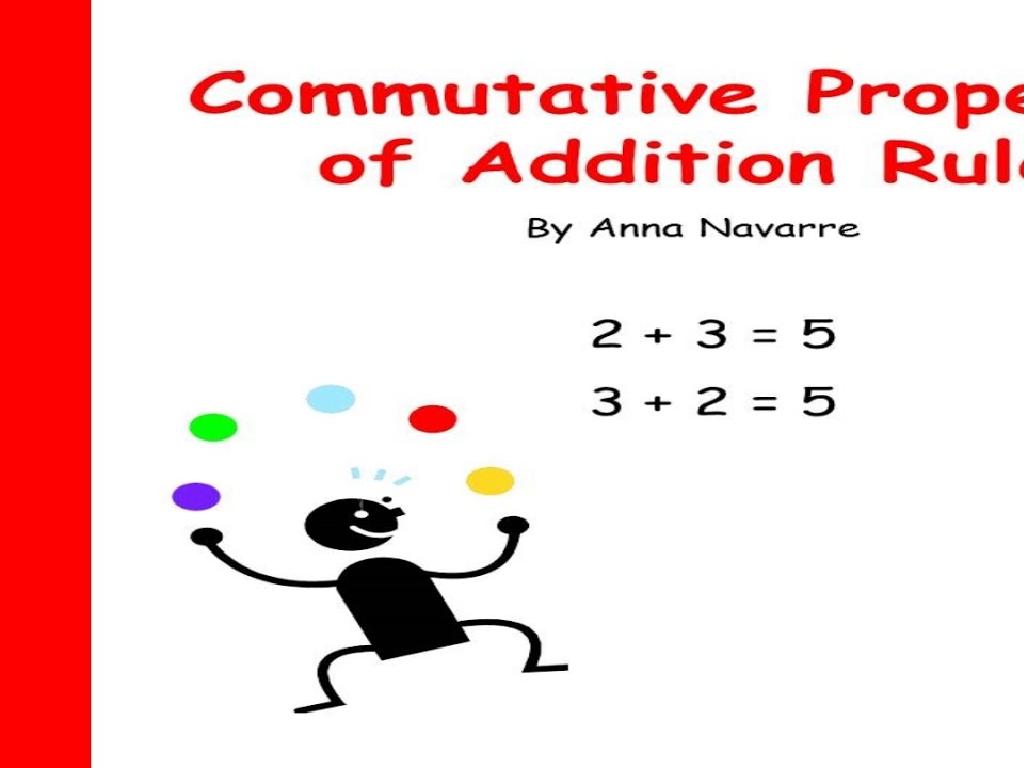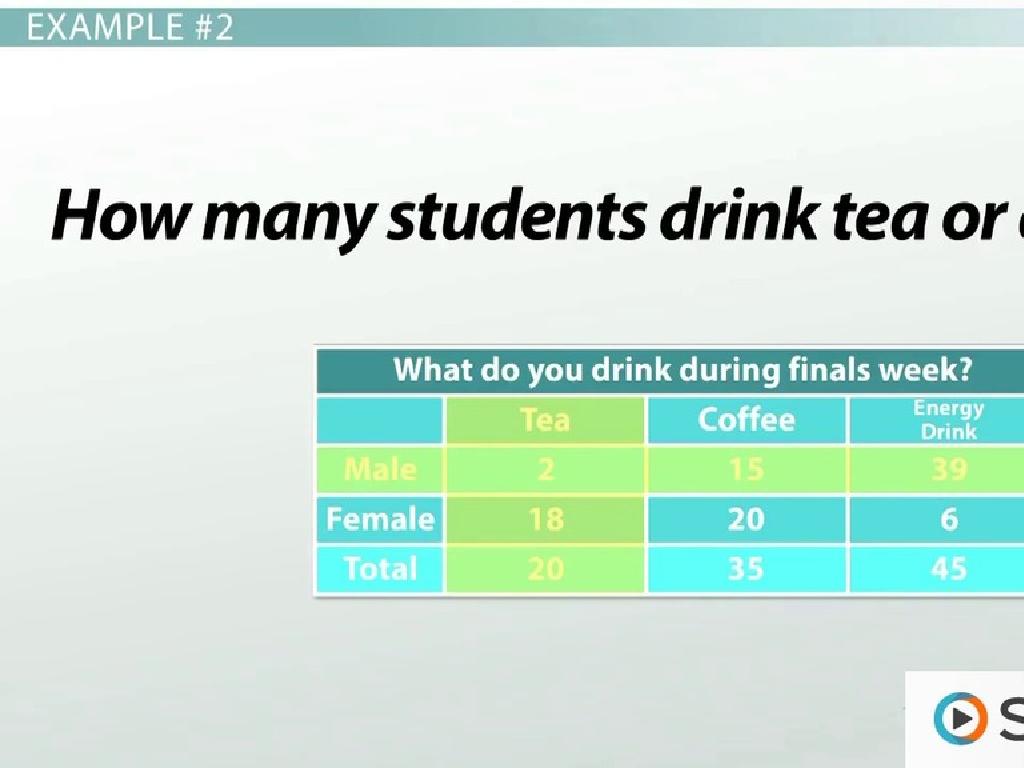Understand Quantity Supplied And Quantity Demanded
Subject: Social studies
Grade: Third grade
Topic: Supply And Demand
Please LOG IN to download the presentation. Access is available to registered users only.
View More Content
Welcome to Supply and Demand!
– Learn about Supply & Demand
– How things are sold and bought
– Like at a lemonade stand or toy store
– Discover ‘quantity supplied’
– How many toys a store wants to sell
– Understand ‘quantity demanded’
– How many toys kids want to buy
|
This slide introduces the basic concepts of supply and demand to third-grade students. Begin by explaining that supply and demand are like two sides of the same coin in how things are sold and bought in markets, such as a lemonade stand or a toy store. ‘Quantity supplied’ refers to how much of something, like toys, a store wants to sell based on the price. ‘Quantity demanded’ is how much of something, like toys, kids want to buy depending on how much it costs. Use simple, relatable examples to illustrate these concepts, such as a scenario where a toy store has a sale and more kids want to buy toys because the price is lower. Encourage students to think of examples from their own experiences where they wanted to buy something or saw something for sale.
The Basics of Supply and Demand
– What is Supply and Demand?
– They are key ideas in how markets work.
– Supply: How much is available
– If a store has 10 apples, that’s its apple supply.
– Demand: How much people want
– If 8 friends want apples, that’s the demand.
– Balance of a market
|
This slide introduces the fundamental concepts of supply and demand, which are crucial for understanding how markets operate. Supply refers to the quantity of a product or service that is available for purchase, while demand refers to the desire of buyers for that product or service. It’s important to convey these concepts in a relatable way for third graders, such as using examples of toys or snacks they might want. Explain that when supply and demand are balanced, prices tend to be stable, but if more people want something that is in limited supply, it might become more expensive. Conversely, if there’s a lot of something but not many people want it, it might be cheaper. Use simple, everyday examples to illustrate these points.
Understanding Quantity Supplied
– What is Quantity Supplied?
– It’s the number of items a seller offers for sale.
– Quantity equals toys to sell
– Think of it like how many toys are on your store’s shelves.
– Your toy store example
– If you have a toy store, how many different toys can customers buy?
– Supply changes with demand
– If more kids want to buy a toy, you might put more on the shelf!
|
This slide introduces the concept of Quantity Supplied in a way that’s relatable to third graders by using the example of a toy store. Begin by explaining that Quantity Supplied refers to how many items a seller has available to sell – just like how many toys a store has on its shelves. Encourage the students to imagine they own a toy store and ask them to think about how many toys they would want to have in their store for customers to buy. Discuss how the number of toys (supply) might change if lots of kids want to buy them (demand increases). This will help them understand the basic concept of supply in the context of supply and demand.
Understanding Quantity Demanded
– What is Quantity Demanded?
– It’s the number of items customers want to buy.
– High demand example with toys
– If many friends want the same toy, the demand for that toy is high!
– Demand affects how many are made
– When more people want a toy, companies try to make more of them.
– More demand can mean higher prices
– Sometimes, if a lot of people want the same thing, it might cost more money.
|
This slide introduces the concept of quantity demanded in a way that’s relatable to third graders. Start by explaining that quantity demanded is simply how many of a certain item people want to buy. Use the example of a popular toy that many classmates might want to illustrate high demand. Discuss how high demand for a toy can lead to more of that toy being produced and potentially a higher price due to its popularity. Encourage students to think of examples of items they wanted because many others did too. This will help them grasp the basic principles of demand in an economic context.
The Balance of Supply and Demand
– Supply & Demand set prices
– Many toys, few friends want
– If you have many toys but nobody wants them, they might become less valuable.
– Few toys, many friends want
– If you have only a few toys but everyone wants them, they might become more valuable.
– Prices change with Supply & Demand
|
This slide introduces the basic concept of supply and demand and how they work together to determine prices. Use relatable examples like toys and friends to explain these economic principles. If there’s a large supply of toys but little demand from friends, the value or ‘price’ of the toys decreases. Conversely, if there’s a small supply of toys but a high demand, the value or ‘price’ increases. This concept can be illustrated with scenarios like a lemonade stand or sharing snacks at lunch. Encourage students to think of times when they had something that many or few of their friends also wanted, and discuss how that affected what they could ‘trade’ for it.
Supply and Demand: Lemonade Stand
– Understanding supply with lemonade
– Supply is how much lemonade we have to sell.
– Demand at our lemonade stand
– Demand is how many people want to buy our lemonade.
– When supply meets demand
– If we have 30 glasses and 30 people want them, supply equals demand.
– Effects of hot weather on demand
– More people want lemonade when it’s hot outside.
|
This slide uses the example of a lemonade stand to explain the concepts of supply and demand in a way that’s relatable to third graders. Supply is the amount of something you have to sell in this case, lemonade. Demand is how many people want what you’re selling. When the supply of lemonade matches the number of people wanting to buy it, we have an equilibrium. The weather can affect demand; on hot days, more people want lemonade to cool down. This example can help students grasp the basic principles of supply and demand in a real-world context that they can understand and visualize.
Activity Time: Supply & Demand Matching Game
– Play a matching game
– Match toys with children’s demand
– If 5 toys and 10 children, how do we match?
– Observe price changes
– Fewer toys than kids may increase price
– Discuss our findings
– Why did prices change with different matches?
|
This interactive activity is designed to help students understand the concepts of supply and demand through a fun matching game. Provide a set of cards with different numbers of toys on them and another set with numbers of children who want these toys. Students will match the supply with the demand and observe how prices can change based on the availability of toys and the number of children wanting them. For example, if there are fewer toys than children, the price might go up because the toys are more desirable. After the activity, discuss with the class why prices changed in their matches. This will help them grasp how supply and demand affect prices in real-life scenarios.
Conclusion: Understanding Supply and Demand
– Supply & Demand in shopping
– Reasons for price changes
– Things can be expensive or cheap depending on how many people want them and how many are available.
– Importance of quantity in markets
– Quantity supplied is how much sellers offer, and quantity demanded is how much buyers want.
– Reflect on what we’ve learned
|
As we wrap up our lesson on supply and demand, it’s important for students to grasp how these concepts play a role in everyday activities like shopping and selling. Supply and demand influence the prices of the things we buy; for instance, if many people want a toy but there aren’t many available, it might be expensive. Conversely, if a store has too many of a certain toy, they might sell it for a cheaper price to get rid of them. Understanding the balance between quantity supplied and quantity demanded helps us make sense of market behaviors and prices. Encourage the students to think of examples from their own experiences where they’ve seen items become more expensive or cheaper, and discuss how supply and demand might have played a part in that.
Class Activity: Supply and Demand Dance
– Learn supply & demand through dance
– Some students are sellers, others buyers
– Dance to ‘buy’ and ‘sell’ items
– Observe supply meeting demand
– Did everyone get what they wanted?
|
This activity is designed to help students understand the concepts of supply and demand in a fun and interactive way. Divide the class into two groups: buyers and sellers. Sellers will have a set number of items (could be pictures or tokens) to ‘sell’, and buyers will have ‘money’ to spend. When the music starts, buyers will approach sellers to ‘buy’ items. When the music stops, discuss as a class whether the buyers were able to purchase what they wanted and if the sellers sold all their items. This will help illustrate if the supply of items was enough to meet the demand. Possible variations of the activity could include changing the number of items for sale or the amount of money buyers have to spend to show how these factors affect supply and demand.






